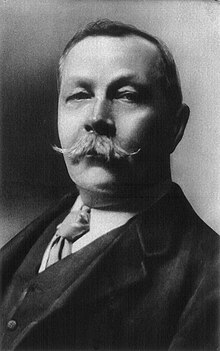About the Author: Arthur Ignatius Conan Doyle was born on 22 May 1859 at 11 Picardy Place, Edinburgh, Scotland. From 1876 to 1881, he studied medicine at the University of Edinburgh, including a period working in the town of Aston (now a district of Birmingham) and in Sheffield, as well as in Shropshire at Ruyton-XI-Towns. While studying, Doyle began writing short stories. His earliest extant fiction, "The Haunted Grange of Goresthorpe", was unsuccessfully submitted to Blackwood's Magazine. His first published piece "The Mystery of Sasassa Valley", a story set in South Africa, was printed in Chambers's Edinburgh Journal on 6 September 1879. On 20 September 1879, he published his first non-fiction article, "Gelsemium as a Poison" in the British Medical Journal. In 1882 he joined former classmate George Turnavine Budd as his partner at a medical practice in Plymouth, but their relationship proved difficult, and Doyle soon left to set up an independent practice. Arriving in Portsmouth in June of that year with less than £10 (£900 today) to his name, he set up a medical practice at 1 Bush Villas in Elm Grove, Southsea. The practice was initially not very successful. While waiting for patients, Doyle again began writing stories and composed his first novels, The Mystery of Cloomber, not published until 1888, and the unfinished Narrative of John Smith, which would go unpublished until 2011. He amassed a portfolio of short stories including "The Captain of the Pole-Star" and "J. Habakuk Jephson's Statement", both inspired by Doyle's time at sea, the latter of which popularized the mystery of the Mary Celeste and added fictional details such as the perfect condition of the ship (which had actually taken on water by the time it was discovered) and its boats remaining on board (the one boat was in fact missing) that have come to dominate popular accounts of the incident. Doyle struggled to find a publisher for his work. His first significant piece, A Study in Scarlet, was taken by Ward Lock Co. on 20 November 1886, giving Doyle £25 for all rights to the story. The piece appeared later that year in the Beeton's Christmas Annual and received good reviews in The Scotsman and the Glasgow Herald. The story featured the first appearance of Watson and Sherlock Holmes, partially modeled after his former university teacher Joseph Bell. Doyle wrote to him, "It is most certainly to you that I owe Sherlock Holmes ... Round the center of deduction and inference and observation which I have heard you inculcate I have tried to build up a man." Robert Louis Stevenson was able, even in faraway Samoa, to recognize the strong similarity between Joseph Bell and Sherlock Holmes: "My compliments on your very ingenious and very interesting adventures of Sherlock Holmes. ... Can this be my old friend Joe Bell?" Other authors sometimes suggest additional influences—for instance, the famous Edgar Allan Poe character C. Auguste Dupin. A sequel to A Study in Scarlet was commissioned and The Sign of the Four appeared in Lippincott's Magazine in February 1890, under agreement with the Ward Lock company. Doyle felt grievously exploited by Ward Lock as an author new to the publishing world and he left them. Short stories featuring Sherlock Holmes were published in the Strand Magazine. Doyle first began to write for the 'Strand' from his home at 2 Upper Wimpole Street, now marked by a memorial plaque. In this period, however, Holmes was not his sole subject and in 1893, he collaborated with J.M. Barrie on the libretto of Jane Annie. Doyle was found clutching his chest in the hall of Windlesham Manor, his house in Crowborough, East Sussex, on 7 July 1930. He died of a heart attack at the age of 71. His last words were directed toward his wife: "You are wonderful." At the time of his death, there was some controversy concerning his burial place, as he was avowedly not a Christian, considering himself a Spiritualist. He was first buried on 11 July 1930 in Windlesham rose garden. He was later reinterred together with his wife in Minstead churchyard in the New Forest, Hampshire. Carved wooden tablets to his memory and to the memory of his wife are held privately and are inaccessible to the public. That inscription reads, "Blade straight / Steel true / Arthur Conan Doyle / Born May 22nd 1859 / Passed On 7th July 1930." The epitaph on his gravestone in the churchyard reads, in part: "Steel true/Blade straight/Arthur Conan Doyle/Knight/Patriot, Physician, and man of letters". Undershaw, the home near Hindhead, Haslemere, south of London, that Doyle had built and lived in between October 1897 and September 1907, was a hotel and restaurant from 1924 until 2004. It was then bought by a developer and stood empty while conservationists and Doyle fans fought to preserve it. In 2012 the High Court ruled that the redevelopment permission be quashed because proper procedure had not been followed. A statue honours Doyle at Crowborough Cross in Crowborough, where he lived for 23 years. There is also a statue of Sherlock Holmes in Picardy Place, Edinburgh, close to the house where Doyle was born.
My Review: This is not among my favorites in the short stories from Sherlock Holmes series, but it is not completely bad. The story revolves around the case of Miss Mary Sutherland, a woman with a substantial income from the interest on a fund set up for her, which she will get full control upon her marriage. She is engaged to a quiet Londoner who has recently disappeared. Sherlock Holmes's detective powers are barely challenged as this turns out to be quite an elementary case for him, much as it puzzles Watson.
The fiancé, Mr. Hosmer Angel, is a curious character, rather quiet, and rather secretive about his life. Miss Sutherland only knows that he works in an office in Leadenhall Street, but nothing more specific than that. All his letters to her are typewritten, even the signature, and he insists that she write back to him through the local Post Office.
The climax of the sad liaison comes when Mr. Angel abandons Miss Sutherland at the altar on their wedding day.
Holmes, noting all these things, Hosmer Angel's description, and the fact that he only seems to meet with Miss Sutherland while her disapproving youngish stepfather, James Windibank, is out of the country on business, reaches a conclusion quite quickly. A typewritten letter confirms his belief beyond doubt. Only one person could have gained by this: Mr. James Windibank. Holmes deduces "Angel" had "disappeared" by simply going out the other side of a four-wheeler cab.
After solving the mystery, Holmes chooses not to tell his client the solution, since "If I tell her she will not believe me. You may remember the old Persian saying, 'There is danger for him who taketh the tiger cub, and danger also for whoso snatches a delusion from a woman.' There is as much sense in Hafiz as in Horace, and as much knowledge of the world." In this, however, he can be accused of not fulfilling his professional duty for which he was paid – namely, to investigate the matter to which she set him, provide her with the results and let her decide what to do with them. Holmes does advise his client to forget "Mr. Angel"; Miss Sutherland refuses to take Holmes' advice and vows to remain faithful to "Angel" until he reappears – for at least ten years.
Holmes predicts Windibank will continue a career in crime and end up on the gallows.
As this is a short story, you should be done reading it in less than a couple of hours.
As this is a short story, you should be done reading it in less than a couple of hours.
If you read this review, feel free to leave a message.



No comments:
Post a Comment